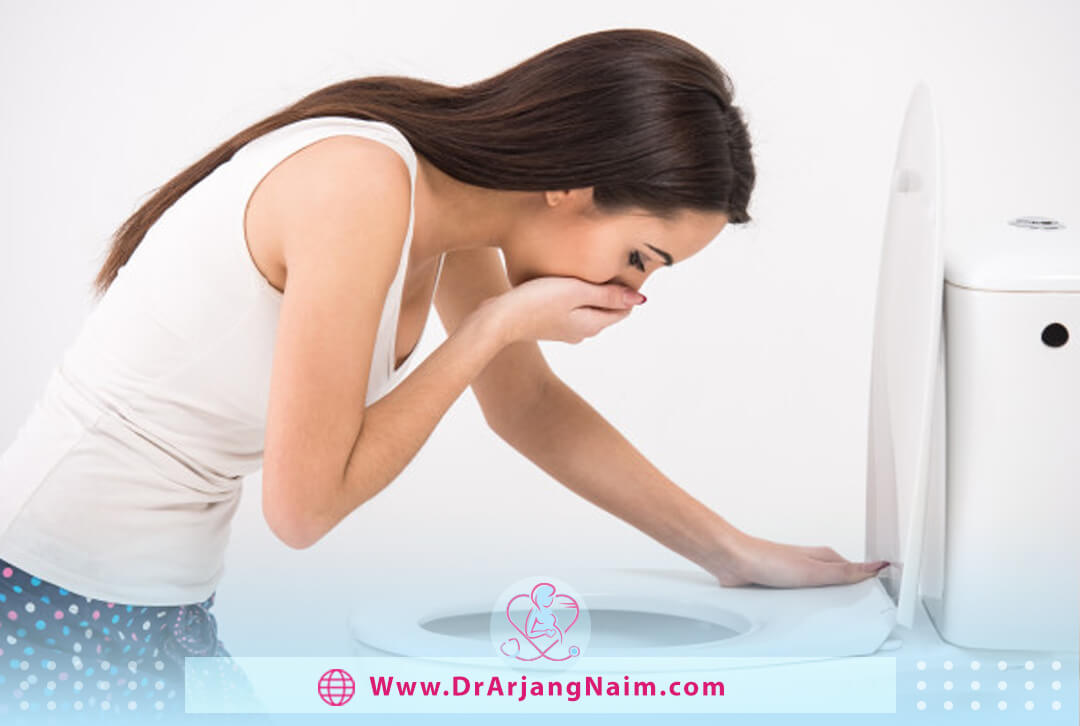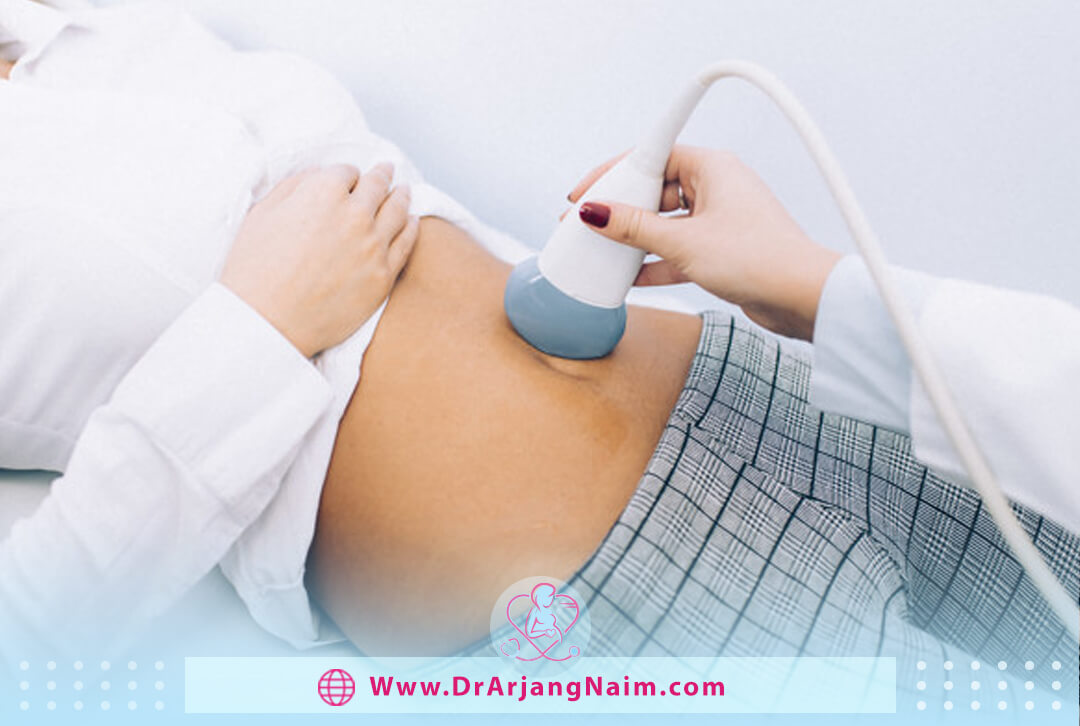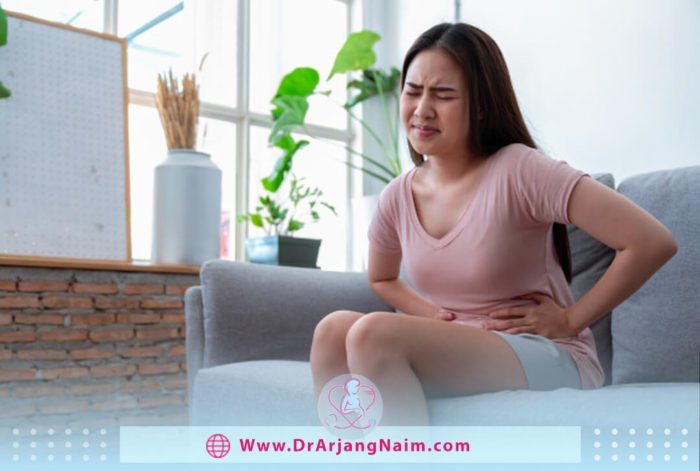There are different types of ovarian cysts. The ovaries are part of the female reproductive system. They are located in the lower abdomen on either side of the uterus. Women have two ovaries that produce eggs and also have the hormones estrogen and progesterone.
Sometimes, a fluid-filled sac called cyst forms in one of the ovaries. Many women get at least one cyst in their lifetime. In most cases, the cysts are painless and do not cause any symptoms. An ovarian cyst is a fluid-filled sac that forms inside the ovary or attaches to it. Sometimes there are other substances in the ovarian cyst besides fluid, such as thin or thick walls inside the cysts, fresh or old blood, and solid tissue, in which case it is called an ovarian mass instead of an ovarian cyst and can be benign or malignant.
Signs and symptoms of an ovarian cyst

Ovarian cysts often do not cause symptoms. In case of symptoms include:
- Vomiting
- Pain during intercourse or menstruation
- Abdominal fullness
- Nausea
- Unusual bleeding
- Weight gain
- Inability to empty the bladder completely
- Breast pain
- Aching in the pelvic region, lower back, or thighs
The following symptoms need immediate medical attention:
- Severe abdominal pain that comes on suddenly
- Fainting
- Weakness
- Dizziness
- Rapid breathing
- Abdominal pain that occurs with vomiting and a fever
Risk factors
Cases that increase the risk of developing ovarian cysts include:
- Hormonal problems: Taking fertility drugs such as clomiphene to help ovulate can increase the risk of cysts.
- Pregnancy: Cysts that develop during ovulation may remain on ovaries and during pregnancy.
- Endometriosis: Cells that are usually inside the uterus grow outside it. These cells can attach to the ovaries and cause cysts to grow.
- A severe pelvic infection: If the infection spreads to the ovaries, it can cause cysts.
- A previous ovarian cyst: If a person has had a cyst before, they can get it again.
Types of ovarian cysts
Different types of ovarian cysts can be treated based on the type of cyst if needed.
Functional cysts
Physiological or non-pathological ovarian cysts, which are functional cysts and are the result of normal ovarian function in the process of egg production, are divided into two categories:
- Follicular cyst: Follicular cysts are also known as benign ovarian cysts or functional cysts. They are basically tissue pockets full of fluid that can build up on or in your ovaries. They are most common in women of childbearing age and as a result of ovulation. It is rare for girls to develop follicular cysts before puberty. Menopausal women are not affected in any way. Any cysts that develop in a woman after menopause should be evaluated.
Most follicular cysts are painless and harmless. They are not cancerous. They often go away on their own in a few menstrual cycles. You may not even notice a follicular cyst. In rare cases, follicular cysts can lead to complications that require medical attention. - Corpus luteum cyst: The egg is released from the dominant follicle during ovulation. Following the release of the egg and subsequent fertilization, the follicle seals itself and forms what is known as the corpus luteum. This cell mass helps produce the hormone progesterone in early pregnancy. The corpus luteum continues to produce progesterone until the fetus produces enough to sustain a pregnancy, usually between 7 and 9 weeks of pregnancy.
When fertilization or implantation does not occur, the corpus luteum decomposes. This lowers estrogen and progesterone levels and leads to the onset of another menstrual cycle. Occasionally, cysts can form in the corpus luteum, leading to
ovarian cysts’ pain symptoms. These cysts go away on their own, but some of them may need treatment.
Pathological cysts
Pathological cysts are caused by abnormal cell growth and are unrelated to the menstrual cycle. They can occur before and after menopause. Pathological cysts develop from cells used to make eggs or cells that line the outside of the ovary.
Dermoid cysts
A dermoid cyst is a sac enclosed near the skin surface that forms during a baby’s development in the womb. Cysts can form anywhere on the body. It may contain hair follicles, skin tissue, and glands that produce sweat and sebum. The glands continue to produce these substances and cause the cyst to grow. Dermoid cysts are common. They are usually safe but require surgery to remove them. They do not resolve on their own.
Dermoid cysts are a congenital disease, which means that they are present at birth. This cyst develops in or on the ovary and has nothing to do with ovarian function. This cyst develops before birth, which is why a woman may have a dermoid cyst in her ovary for years until it is discovered on a pelvic exam.
Endometrial cysts
Chocolate cysts or Endometrial Cysts are noncancerous, fluid-filled cysts that typically form deep in the ovaries. They get their name from their brown, string-like appearance and look like melted chocolate. They are also called ovarian endometrium. This color comes from menstrual blood and old tissue that fills the cyst cavity. Chocolate cysts can affect one or both ovaries and maybe multiple or single.
Chocolate cysts occur in 20 to 40% of women with endometriosis. Endometriosis is a common disorder in which the lining of the uterus, known as the endometrium, grows outside the uterus and on the ovaries, fallopian tubes, and other areas of the reproductive system. Overgrowth of this coating causes severe pain and sometimes infertility.
Cystadenomas
Cystadenoma is a benign tumor that develops from ovarian tissue. They may be filled with mucous fluid. Cystadenomas can be very large, 12 inches or more in diameter. An ovarian adenoma cyst is benign; if it is small, it does not cause a problem. If the cyst is very large and causes severe pain, it can be treated with surgery.
Malignant
Most ovarian cysts are harmless and often go away on their own without treatment. Pathological ovarian cysts can sometimes be malignant, making them more likely to develop ovarian cancer. People who have gone through menopause are more likely to develop pathological cysts.
Complications
Some women may have unusual complications with ovarian cysts. During the pelvic exam, the doctor may notice things that include:
- Ovarian torsion: If the cysts become large, they can move and twist the ovaries. This twist is very painful.
- Rupture: Cysts can open and cause severe pain and bleeding, especially if the cysts are large. Sex and other activities may increase the risk of rupture. A ruptured cyst sometimes heals on its own but often requires medical attention.
- Infected ovarian cyst: Ovarian cysts can develop in response to pelvic infection and cause an abscess. If an abscess ruptures, dangerous bacteria may spread throughout the body.
Prevention
Although there is no way to prevent ovarian cysts, regular pelvic exams can help detect ovarian changes as soon as possible. Women should be aware of changes in their menstrual cycle, including unusual menstrual symptoms, especially those that last for more than a few periods. In this case, talk to a gynecologist.
Diagnosis

Examination of the pelvis reveals cysts on the ovary. Depending on the size and whether it is full of liquids, solids, or mixed, the doctor may recommend tests to determine the type and whether treatment is needed. Possible tests include the following:
- Pregnancy test: A positive pregnancy test can indicate a corpus luteum cyst.
- Pelvic ultrasound: A wand-like device (transducer) sends and receives high-frequency sound waves to create an image of the uterus and ovaries on the film screen. The doctor analyzes the image to confirm the presence of the cyst, helps identify its location, and determines if it is solid, fluid-filled, or mixed.
- Laparoscopy: A light and narrow instrument that is inserted into the abdomen through a small incision; the doctor can see the ovaries and remove the ovarian cyst.
- CA 125 blood test: Blood levels of a protein called cancer 125 antigens (CA 125) are often elevated in women with ovarian cancer. If the cyst is somewhat solid and the person is at high risk for ovarian cancer, the doctor may order this test. Elevated levels of CA 125 can also occur in non-cancerous conditions such as endometriosis, uterine fibroids, and pelvic inflammatory disease.
- Hormone Levels: the doctor may order a pregnancy test and assess hormone levels. Blood tests can also be done to test for other hormones that may be causing polycystic ovary syndrome.
Treatment

Treatment depends on the age, type of cyst, size of the cyst, and symptoms. The doctor will suggest one of the following treatments.
Watchful waiting
If the person has no symptoms and the ultrasound shows that the person has a simple, small, fluid-filled cyst, in many cases, the doctor will recommend that the person wait and be re-examined to see if the cyst disappears within a few months.
Medication
The doctor may prescribe hormonal contraceptives such as birth control pills to prevent the recurrence of ovarian cysts. However, birth control pills do not shrink existing cysts.
Surgery
The doctor may suggest removing a large cyst that does not look like a functional cyst, is growing and continues for two or three periods, or causes pain.
Some cysts can be removed without removing the ovary. In some cases, the doctor may remove the damaged ovary and hold another ovary that is healthy. The doctor will probably refer the woman to a gynecologic cancer specialist if it is a cancerous cystic mass. The uterus, ovaries, and fallopian tubes may need to be removed, and chemotherapy or radiation may be needed. The doctor may also recommend surgery if a woman develops a postmenopausal ovarian cyst.
What is the prognosis of an ovarian cyst?
The prognosis for women, especially premenopausal women with functional ovarian cysts, is very good. Most of these cysts go away on their own within a few months without treatment. The prognosis for women with other types of ovarian cysts depends on several factors. Age, health status, and the main cause of cysts in women are effective factors in prognosis.
Age
Hormonal stimulation of the ovaries determines the growth of ovarian cysts. A woman who is still menstruating and producing estrogen is more likely to get cysts. Menopausal women have a lower risk of developing ovarian cysts because they no longer ovulate and do not produce large amounts of hormones. Younger women with higher hormone levels are more likely to develop ovarian cysts than postmenopausal women.
Cyst size
The size of the cyst corresponds directly to the rate at which it shrinks. Most functional cysts are 2 inches or less in diameter and do not require surgery to remove them. However, cysts larger than 4 cm in diameter usually require surgery.
Impact of ovarian cysts on fertility
Normally, most ovarian cysts have no effect on the chances of getting pregnant. Sometimes, the disease that causes cysts can make pregnancy more difficult. Two diseases that cause ovarian cysts and affect fertility include:
- Endometriosis
- Polycystic ovary syndrome (PCOS)
The bottom line
Most cysts go away in a few months. However, recurrent ovarian cysts can occur in postmenopausal women and women with hormone imbalances. If left untreated, some cysts can reduce fertility. This is common with endometrium and polycystic ovary syndrome. To improve fertility, the doctor may remove or shrink the cyst. Functional cysts, cystadenomas, and dermoid cysts have no effect on fertility.
Most gynecologists recommend patience and regular examination for cysts, but in some cases, they recommend that the cyst be removed surgically. Especially in postmenopausal people, this is because the risk of developing a cancerous cyst or ovarian cancer after menopause increases. However, ovarian cysts do not increase the risk of ovarian cancer. Some gynecologists recommend surgery if the cyst is more than 5 cm in diameter.
Dr. Arjang Naim MD diagnoses the type of cyst through examination and necessary tests and recommends the necessary treatment measures according to the patient’s condition.
Additional questions
- What is clomiphene used for?
Clomiphene induces ovulation in women who are not producing eggs but want to become pregnant. Clomiphene is in a class of medications called ovulation stimulants.
2. Is an infected cyst life-threatening?
Cysts may not be dangerous, but the most important thing about them is that if left untreated, they can lead to a number of complications, including blood poisoning.
3. What level of CA-125 indicates cancer?
CA-125 levels in the body are measured in units per millimeter (U/mL). A range of 0 to 35 is considered normal. Levels above 35 U/mL may indicate cancer or other conditions.
4. What conditions other than cancer increase ca 125?
- Endometriosis
- Liver disease
- Menstruation
- Pelvic inflammatory disease
- Pregnancy
- Uterine fibroids
5. What are the implications of ovarian cysts on pregnancy?
Some ovarian cysts are associated with reduced fertility, while others are not. Endometriomas and cysts caused by polycystic ovary syndrome may reduce a woman’s ability to conceive. However, functional cysts, dermoid cysts, and cystadenomas are not associated with difficulty conceiving unless they are large.
References
https://www.medicinenet.com/cystadenoma/definition.htm
https://www.medicalnewstoday.com/articles/322651
https://www.mayoclinic.org/diseases-conditions/ovarian-cysts/diagnosis-treatment/drc-20353411
https://www.webmd.com/women/endometriosis/endometrial-cysts
https://www.healthline.com/health/womens-health/chocolate-cyst
https://www.medicalnewstoday.com/articles/320433#diagnosis-of-an-ovarian-cyst-
https://www.healthline.com/health/follicular-cyst
https://www.healthline.com/health/dermoid-cyst#complications




